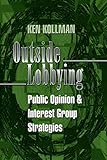Outside Lobbying : Public Opinion and Interest Group Strategies / Ken Kollman.
Material type: TextPublisher: Princeton, NJ : Princeton University Press, [2021]Copyright date: ©1998Description: 1 online resource (216 p.) : 14 tables 17 line illusContent type:
TextPublisher: Princeton, NJ : Princeton University Press, [2021]Copyright date: ©1998Description: 1 online resource (216 p.) : 14 tables 17 line illusContent type: - 9780691221472
- POLITICAL SCIENCE / Political Process / General
- 3M Corporation
- American Petroleum Institute
- Banks, Jeffrey
- Bonner and Associates
- Business Roundtable
- Chaffee plan
- Clinton, Bill
- Donnelly, Brian (D-MA)
- Endangered Species Act
- Exxon Corporation
- First Amendment
- General Motors Corporation
- Gray Panthers
- Greenpeace USA
- Jews
- Jones, Brian
- Kernell, Samuel
- Kingdon, John
- LTV Corporation
- Moe, Terry
- Olson, Mancur
- United We Stand
- Wall Street Journal
- Weingast, Barry
- Zero Population Growth
- agenda-shaping stage
- conflict expansion
- coordination problems
- direct mail fundraising
- factor analysis
- focal points
- framing
- hat trick story
- health care
- inside lobbying
- intensity dilemma
- logit analysis
- mail to Congress
- mass media
- need for action stage
- persuasion theory
- popularity
- press conferences
- referendums
- resource mobilization theories
- right wing groups
- salience
- senior citizen groups
- signaling
- teachers unions
- truck drivers
- online - DeGruyter
| Item type | Current library | Call number | URL | Status | Notes | Barcode | |
|---|---|---|---|---|---|---|---|
 eBook
eBook
|
Biblioteca "Angelicum" Pont. Univ. S.Tommaso d'Aquino Nuvola online | online - DeGruyter (Browse shelf(Opens below)) | Online access | Not for loan (Accesso limitato) | Accesso per gli utenti autorizzati / Access for authorized users | (dgr)9780691221472 |
Frontmatter -- Contents -- Figures -- Tables -- Preface -- 1. Introduction -- 2. Tactics and Strategies -- 3. Outside Lobbying as Costly Signaling -- 4. Public Opinion and Mobilization -- 5. Outside Lobbying as Conflict Expansion -- 6. Lobbying over Trade Policy -- 7. Conclusion -- Appendixes -- A. Groups and Persons Interviewed -- B. Questionnaire for Interest Groups -- C. Opinion Questions -- D. A Signaling Model of Outside Lobbying -- Bibliography -- Index
restricted access online access with authorization star
http://purl.org/coar/access_right/c_16ec
In Outside Lobbying, Ken Kollman explores why and when interest group leaders in Washington seek to mobilize the public in order to influence policy decisions in Congress. In the past, political scientists have argued that lobbying groups make outside appeals primarily because of their own internal dynamics--to recruit new members, for example. Kollman, however, grants a more important role to the need for interest group leaders to demonstrate popular support on particular issues. He interviewed more than ninety interest group leaders and policy makers active on issues ranging from NAFTA to housing for the poor. While he concludes that group leaders most often appeal to the public when they perceive that their stand has widespread popular support, he also shows that there are many important and revealing exceptions to this pattern. Kollman develops his theory of outside lobbying through a combination of rational choice modeling and statistical tests that compare public opinion data with data from his interviews about interest groups' policy positions and activities. The tests reveal that group leaders use outside lobbying to take advantage of pre-existing public preferences, not to recruit members or to try to generate the mere appearance of grass-roots support. Kollman's innovative book will clarify the complex relationship among lobbying, public opinion, and public policy, and will set a new standard for interest group research.
Mode of access: Internet via World Wide Web.
In English.
Description based on online resource; title from PDF title page (publisher's Web site, viewed 30. Aug 2021)


